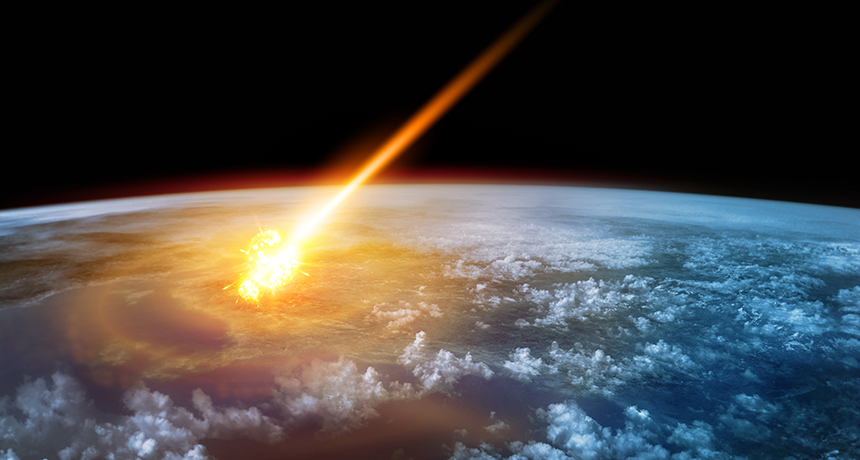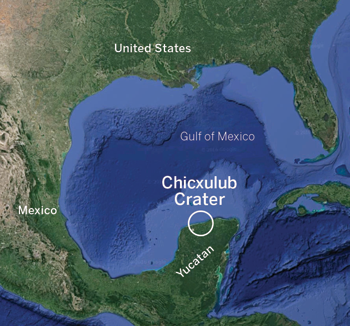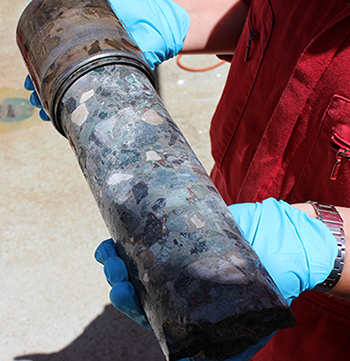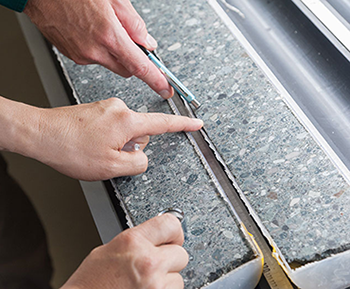Reliving the last day of the dinosaurs
Geologic sites are telling the story of the asteroid impact that abruptly changed life on Earth

A massive asteroid hit the Earth 66 million years ago. The explosive collision rattled the planet and changed its climate. The devastating changes it triggered abruptly wiped out the dinosaurs — and most other living species.
solarseven/iStock/Getty Images Plus
By Beth Geiger
Let’s travel back 66 million years to a balmy day in what is now Texas. A herd of 30-ton alamosaurs graze peacefully in a steamy marsh. Suddenly, a blinding light and a scorching fireball envelops them.
It is the last thing these dinosaurs see.
Fifteen hundred kilometers (900 miles) away, an asteroid moving at 50 times the speed of sound has just slammed into the Gulf of Mexico. The space rock is huge — 12 kilometers (7 miles) wide — and white hot. Its splashdown vaporizes a portion of the Gulf’s water and much of the limestone below.
The aftermath is history: a monstrous crater, major extinctions and the end of dinosaurs. In fact, the impact forever changed the course of life on Earth. With dinosaurs gone, mammals rose to dominate the land. New ecosystems formed. From the ashes, a new world arose.
But what really happened on that very violent, very last day of the Cretaceous (Kreh-TAY-shuus) Period? As scientists peer underground in the Gulf of Mexico and elsewhere, new details are emerging.
Mystery crater
The fossil record clearly shows a major extinction at the end of the Cretaceous. Dinosaurs that had walked the Earth for tens of millions of years vanished suddenly. Why remained a mystery for many years.
Then in the 1980s, geologists noticed a distinct layer of rock in many places around the world. The layer was very thin, generally no more than a few centimeters (several inches) thick. It always occurred at exactly the same place in the geologic record: where the Cretaceous ended and the Paleogene Period began. And everywhere it was found, the layer was packed with the element iridium.
Iridium is extremely rare in Earth rocks. It is, however, common in asteroids.
The iridium-rich layer was all over the Earth. And it appeared at the same moment in geologic time. That suggested that a single, very big asteroid had struck the planet. Bits of that asteroid had flown into the air and traveled around the globe. But if the asteroid was so big, where was the crater?
“Many felt it must be at sea,” says David Kring. “But the location remained a mystery.” Kring is a geologist at the Lunar and Planetary Institute in Houston, Texas. He was part of a team that joined that search for the crater.

In about 1990, the team discovered that same iridium-rich layer in the Caribbean nation of Haiti. But here it was thick — a half-meter (1.6-feet) thick. And it held telltale signs of an asteroid impact, such as drops of rock that had melted, then cooled. Minerals in the layer had been shocked — or altered — by sudden, intense pressure. Kring knew the crater must be nearby.
Then an oil company revealed its own odd find. Buried under Mexico’s Yucatán Peninsula was a semicircular rock structure. Years before, the company had drilled into it. They thought it must be a volcano. The oil company let Kring examine the core samples it had collected.
As soon as he studied those samples, Kring knew they had come from a crater made by the asteroid’s impact. It stretched more than 180 kilometers (110 miles) across. Kring’s team named the crater Chicxulub (CHEEK-shuh-loob), after the Mexican town now near an above-ground site at its center.
Into Ground Zero

In 2016, a new scientific expedition set out to study the 66-million-year-old crater. The team brought a drill rig to the site. They mounted it on a platform that stood on the seafloor. Then they drilled deeply into the seabed.
For the first time, the researchers were targeting a central part of the crater called the peak ring. A peak ring is a circular ridge of crumbled rock inside an impact crater. Up until then, scientists had seen peak rings on other planets and the moon. But the one within Chicxulub is the clearest — and perhaps only — peak ring on Earth.
One of the scientists’ goals was to learn more about how peak rings form. They had plenty of other questions, too. How did the crater form? What happened just after? How quickly did life within it recover?
ECORD/IODP
Sean Gulick helped lead the expedition. As a geophysicist at the University of Texas in Austin, he studies physical properties that shape the Earth.
The expedition drilled more than 850 meters (2,780 feet) into Chicxulub. As the drill spun deeper, it cut a continuous core through the rock layers. (Imagine pushing a drinking straw down through a layer cake. The core collects inside the straw.) When the core emerged, it showed all the rock layers the drill had gone through.
The scientists arranged the core in long boxes. Then they studied every inch of it. For some analyses, they just looked at it very closely, including with microscopes. For others, they used laboratory tools such as chemical and computer analyses. They turned up many interesting details. For example, the scientists found granite that had splashed to the surface from 10 kilometers (6.2 miles) below the Gulf floor.

Along with studying the core directly, the team also combined data from the drill core with simulations that it made using a computer model. With these, they reconstructed what had happened on the day the asteroid struck.
First, explains Gulick, the impact made a dent 30 kilometers (18 miles) deep in the Earth’s surface. It was like a trampoline stretching down. Then, like that trampoline bouncing back up, the dent instantly rebounded from the force.
As part of that rebound, shattered granite from 10 kilometers below exploded upward at more than 20,000 kilometers (12,430 miles) per hour. Like a splash, it blasted tens of kilometers high, then collapsed back into the crater. That formed a circular mountain range — the peak ring. The final result was a wide, flat crater about one kilometer (0.6 mile) deep, with a peak ring of granite inside it that’s 400 meters (1,300 feet) high.
“The whole thing took seconds,” Gulick says.
And the asteroid itself? “Vaporized,” he says. “The iridium layer found all over the world is the asteroid.”

No-good, very bad day
Close to the crater, the air blast would have reached 1,000 kilometers (621 miles) per hour. And that was just the beginning.
Joanna Morgan is a geophysicist at Imperial College London in England who co-led the drilling expedition with Gulick. She studies what happened immediately after the collision. “If you were within 1,500 kilometers [932 miles], the first thing you would see was a fireball,” says Morgan. “You are dead quite soon after that.” And by “quite soon,” she means instantly.
From farther away, the sky would have glowed bright red. Huge earthquakes would have rocked the ground as the impact rattled the entire planet. Wildfires would have ignited in a flash. The asteroid’s mega-splash would have triggered towering tsunamis that radiated across the Gulf of Mexico. Droplets of glassy, melted rock would have rained down. They would have glowed in the darkening sky like thousands of tiny shooting stars.

Inside the drill core, a layer of rock just 80 centimeters (31 inches) thick records those first days and years after the impact. Scientists call this the “transitional” layer because it captures the transition from impact to aftermath. It holds a jumble of melted rock, glassy droplets, silt washed in by tsunamis and charcoal from forest fires. Mixed in are smashed remains of the last Cretaceous inhabitants.
Thousands of kilometers away from Chicxulub, huge waves sloshed back and forth in Earth’s lakes and shallow seas — like a bowl of water when you slam your fist on the table. One of those shallow seas extended north from the Gulf of Mexico. It covered parts of what is now North Dakota.
There, at a site called Tanis, paleontologists made an amazing discovery. A layer of soft rock 1.3 meters (4.3 feet) thick chronicles the very first moments after impact. It’s as clear as a modern crime scene, right down to the actual victims.
Paleontologist Robert DePalma has been excavating this late-Cretaceous layer for six years. DePalma is the curator of the Palm Beach Museum of Natural History in Florida. He’s also a graduate student at the University of Kansas in Lawrence. At Tanis, DePalma unearthed a jumble of marine fish, freshwater species and logs. He even found what appear to be pieces of dinosaurs. The animals look like they were violently torn apart and tossed around.
By studying the site, DePalma and other scientists have determined that Tanis was a riverbank near the shore of the shallow sea. They believe that the remains at Tanis were dumped within minutes of the impact by a powerful wave called a seiche (SAYSH).
Seiches don’t travel long distances as tsunamis do. Instead, they’re more local, like giant but short-lived ripples. The massive earthquake after the impact likely triggered a seiche here. The huge wave would have radiated across the sea, tumbling fish and other animals ashore. More waves buried everything.

Mixed into the debris at Tanis are little beads of glass called tektites. These form when rock melts, gets blasted into the atmosphere, then falls like hail from the sky. Some of the fossilized fish even had tektites in their gills. While taking their last breaths, they would have choked on those beads.
The age of the Tanis deposit and the chemistry of its tektites are an exact match for the Chicxulub impact, DePalma says. If the creatures at Tanis really were killed by the effects of the Chicxulub impact, they are the first of its direct victims ever found. DePalma and 11 co-authors published their findings April 1, 2019, in the Proceedings of the National Academy of Sciences.
Big chill
The asteroid didn’t just vaporize itself. The strike also vaporized sulfur-rich rocks beneath the Gulf of Mexico.
When the asteroid hit, a plume of sulfur, dust, soot and other fine particles shot well over 25 kilometers (15 miles) into the air. The plume quickly spread around the globe. If you could have seen Earth from space then, Gulick says, overnight it would have transformed from a clear blue marble to a hazy brown ball.
On the ground, the effects were devastating. “Just the soot by itself would have basically blocked out the sun,” Morgan explains. “It caused very rapid cooling.” She and her colleagues used computer models to estimate just how much the planet cooled. Temperatures plunged by 20 degrees Celsius (36 degrees Fahrenheit), she says.
For about three years, much of Earth’s land surface stayed below freezing. And the oceans chilled for hundreds of years. Ecosystems that had survived the initial fireball later collapsed and vanished.
Among animals, “Anything bigger than 25 kilograms [55 pounds] would not have survived,” Morgan says. “There was not enough food. It was cold.” Seventy-five percent of Earth’s species went extinct.

From crater of death to cradle of life
Yet some species were suited to survive the devastation. The tropics stayed above freezing, which helped some species there endure. The oceans also didn’t cool as much as the land had. “Things that survived best were ocean-bottom dwellers,” says Morgan.
Ferns, which are tolerant of darkness, led the recovery of plants on land. In New Zealand, Colombia, North Dakota and elsewhere, scientists have discovered rich pockets of fern spores just above the iridium layer. They call it the “fern spike.”
There also were our small, furry mammal ancestors. These creatures didn’t need much to eat. They could withstand cold better than could large reptiles, such as the dinosaurs. And they could hide for a long time, if needed. “Small mammals could burrow or hibernate,” Morgan points out.
Even within the Chicxulub crater, life came back surprisingly quickly. The intense heat of the impact would have sterilized much of the area. But Christopher Lowery found signs that some life returned within just 10 years. He studies ancient marine life at the University of Texas in Austin.
In rock cores from the 2016 drilling expedition, Lowery and his colleagues found fossils of single-celled creatures called foraminifera (For-AM-uh-NIF-er-uh). These tiny, shelled animals were some of the first life to reappear in the crater. Lowery’s team described them in the May 30, 2018 issue of Nature.
In fact, says Kring, life may have bounced back extra rapidly here. “Surprisingly, recovery within the crater was faster than some other places farther from the crater,” he notes.

Lingering heat from the impact may have supported a hotbed of microbes and other new life. As at hydrothermal vents in today’s oceans, hot water flowing through the fractured, mineral-rich rock within the crater could have supported new communities.
The crater, initially a place of violent death, became a cradle for life. The Cretaceous Period was over and the Paleogene Period had begun.
Within 30,000 years, a thriving, diverse ecosystem had taken hold.
Still life with crater
Some scientists debate whether the Chicxulub impact acted alone in wiping out the dinosaurs. Halfway around the planet, in India, a massive outpouring of lava also may have played a role. Yet there is no doubt about the Chicxulub asteroid’s devastating impacts, nor the gaping crater it gouged into Earth’s surface.
Over millions of years, the crater disappeared beneath new layers of rock. Today, the only above-ground sign is a semicircle of sinkholes that curves across the Yucatán peninsula like a gigantic thumbprint.
Those sinkholes, called cenotes (Seh-NO-tayss), trace the rim of the ancient Chicxulub crater hundreds of meters below. The buried crater rim shaped the flow of underground water. That flow eroded the limestone above, making it crack and collapse. The sinkholes are now popular swimming and diving spots. Few people who splash in them might guess that they owe their cool, blue waters to the fiery end of the Cretaceous Period.
The vast Chicxulub crater has all but disappeared from view. But the impact of that single day continues 66 million years later. It changed the course of life on Earth forever, creating a new world where we and other mammals now flourish.








